In this section of the beginner’s guide to golf we move on from the theory of the last part and take a look at basic actions and to-dos of a good golf swing.
I won’t go into great detail here as there are enough great books out there (as listed in the last part).
But I will mention all the things that I think are important especially things to look out for if you are just starting out and want to improve fast.
Grip
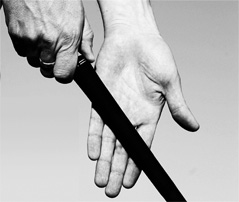

[clearboth] Most beginners grip the club with their left hand in front of their body.
Doing this usually leads to the grip of the club being too much in the palms of their hands.
This can lead to an open club face during the golf swing and thus to a slice (The ball is curving from left to right.).
So I suggest to you to grip your club on the right side of your body first using your left hand.
The grip of the club should go diagonally through your palm and the second joint of your left index finger.
Every beginning golfer should avoid trouble by making it a habit to grip the club on the left side of their body.
By doing so you close the club face more and make it easier to hinge your hands during the swing. When the golfer holds the club directly in front of the middle of his body he should see two knuckles of his hand.
The V between his left thumb and forefinger should point towards his right shoulder. The right hand is added to the right to complete the grip.
The grip with the right hand should be mainly in the fingers. So watch out to not put it too much into your right palm.
[clearboth]
Wrists
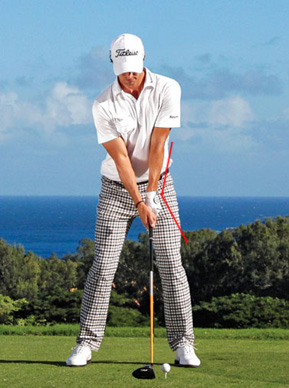
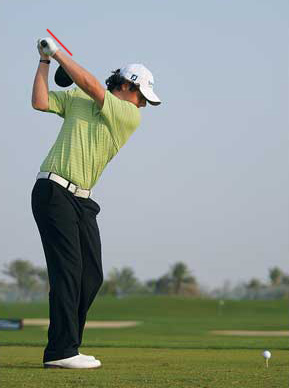
[clearboth] At the beginning of the golf swing there’s an angle between the left back of the hand and the left forearm.
This angle needs to be eliminated before impact or else the ball will go to the right.
That’s why you should try to form a straight line between your back of your left hand and left forearm at the top of your back swing.
[clearboth]
Swing Planes of the Golf Swing
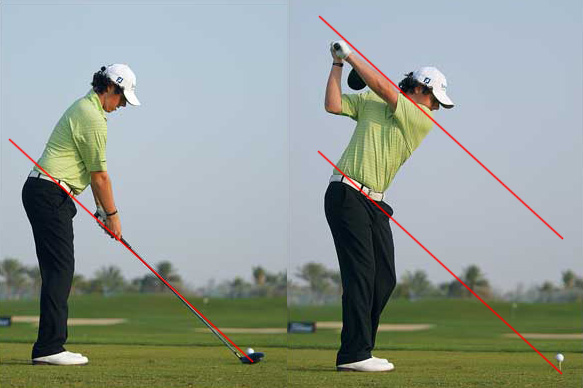
[clearboth]
The club should ideally be in the same angle compared to the ground it was during setup.
But during a classic swing it can’t stay in the same plane throughout the swing.
Because you are naturally lifting your arms during your back swing and moving it down again during your downswing the club travels on several planes that are parallel to each other.
Most professional players have the talent to move their club in the right positions just before impact despite changing planes.
Most beginners don’t have that talent yet and should therefore focus especially on keeping their club at the same angle throughout their swing.
Here are seven reference points to look out for at the top of the back swing:
- The left arm should be parallel to the original swing plane from setup.
- The left arm should be parallel to the original swing plane from setup.
- The end of the grip is perpendicular to the heels.
- The right upper arm points down in an angle of 45 degrees.
- The arms are a little steeper than the shoulders.
- The neck of the golfer can be seen from the side.
- The right elbow touches the swing plane.
- The hands are a little higher than the head.
[clearboth]
Posture
The right posture makes it easier to swing the club on the right plane and time the movements for maximum power.
The address position should be balanced and make it possible to twist the upper body optimally.
The knees are slightly bend but don’t move forward. The flexed knees should move the hips back slightly.
The upper body is tilted approximately 30 degrees from the waist.
The arms are hanging relaxed from the body and are behind the chin. The distance between the left hand and the left thigh should be approximately one tor two hands. The feet should be shoulder width apart. (see picture of Rory McIlroy above)
[clearboth]
Alignment
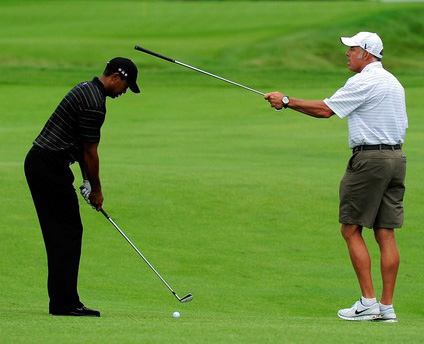
[clearboth] Alignment and aiming are two different things. When you are making straight shots aiming is relatively easy.
If the ball is flying into different directions you will sooner or later begin to aim intuitively in the opposite direction.
But you should always align yourself independent from where the ball is going. A proper alignment is to not have any body parts (shoulders, hips, feet) twisted into one each other.
E.g. if the feet are aligned parallel to the target line but the shoulders are showing to the right of it you are not properly aligned.
Your shoulders, your hips as the imaginary line between your knees and your feet should be aligned parallel to the target line. The target line runs from the ball towards the target (Duh!).
[clearboth]
Timing

[clearboth] The right timing is one of the most important aspects to hit a golf ball powerful and long.
Generating a lot of force with the body doesn’t do much if that force isn’t transferred over to the club and ultimately to the ball.
Timing means in golf to use your hips, shoulders, arms and hands in a way that the energy is transferred from one body part to the next with minimal loss.
That means that the club accelerates as the last part of the chain but with the most speed. Keep that in mind when working on your swing.
Usually players who are being told to slow down or to use less force have a problem with their timing.
Here are two videos of two of the best golfers who ever lived (Ben Hogan and Tiger Woods) to give you an idea of what great timing and balance looks like.
[clearboth]
This concludes the basic look at the full golf swing. In the next parts we’ll learn more about the short game of golf which consists of putting, chipping, pitching and sand play.:

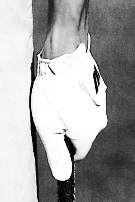
Leave a Reply